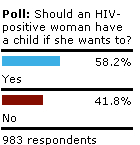Poll: Should an HIV-positive woman have a child if she wants to? [May 2008]
Since the beginning of the HIV/AIDS epidemic, the number of women living with HIV/AIDS and the rate of new infections among women has risen steadily. In the U.S. in 1985, women represented Poll-pregnancy
8 percent of HIV/AIDS diagnoses, compared with 26 percent in 2006. The majority of new HIV infections occur among women of child-bearing age.
amfAR supported the early research that ultimately led to the use of antiretrovirals (ARVs) to prevent mother-to-child transmission of HIV. As a result, in developed nations, this mode of transmission of HIV has been dramatically reduced; nearly 100 percent of women are given the necessary ARVs from the second trimester through the duration of the pregnancy to prevent the child from contracting HIV.

Poll closed May 15, 2008 |
But in resource-limited regions where ARVs are not widely available, HIV transmission from mother to child remains widespread. According to UNAIDS, the vast majority of the Pregnant woman.
2.1 million children younger than 15 living with HIV worldwide in 2007 were infected before birth, during delivery, or while breastfeeding. Every day, 1,200 children across the world become infected with HIV; an estimated 90 percent of these live in sub-Saharan Africa. Often spurned by families and communities, HIV-positive women and their children face stigma and discrimination that can prevent them from securing even the basic necessities of life.
Stigma continues to surround the pregnancy of HIV-positive women in the developed world, as well. In a recent amfAR-sponsored Harris Interactive survey, which questioned nearly 5,000 participants on their perceptions of women with HIV, only 14 percent of respondents felt that HIV-positive women should have children, despite the availability of ARVs to prevent mother-to-child transmission. A full third of respondents said that they would not support an HIV-positive woman’s decision to have a child.
This stigma has a multidimensional impact on HIV-positive women’s psychological well-being, self-perception, health, and ability to make decisions about having a child. The results of the amfAR Harris poll indicate that even after the healthcare advances of the two decades, many people are still unprepared to support the reproductive rights of HIV-positive women.
References
Carr RL, Grambling LF. Stigma: A health barrier for women living with HIV/AIDS. Journal of the Association of Nurses in AIDS Care. 2004;15(5):30-39.
Duffy L. Suffering, shame and silence: The stigma of HIV/AIDS. Journal of the Association of Nurses in AIDS Care. 2005;16(1):13-20.
CDC. HIV/AIDS Fact Sheet. HIV/AIDS Among Women. [Revised June 2007].
Mclntyre J. Strategies to prevent mother to child transmission of HIV. Current Opinion in Infectious Diseases. 2006;19:33-38.
United Nations General Assembly, Call for Action: Elimination of HIV Infections in Infants and Children. Prevention of Mother to Child Conference High Level Global Partners Forum, Abuja, Nigeria. [March 2005].
Washington, D.C., Department of Health HIV/AIDS Fact Sheet. Snapshot. HIV/AIDS Among Children Less Than 13 Years of Age in the District of Columbia, 2007.